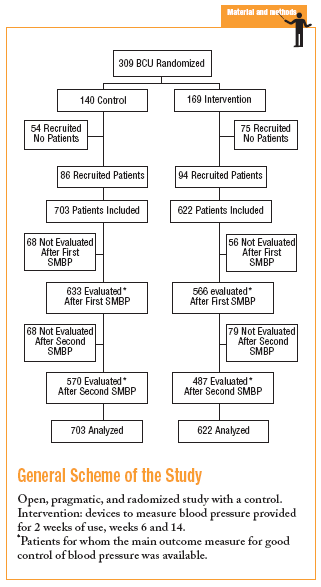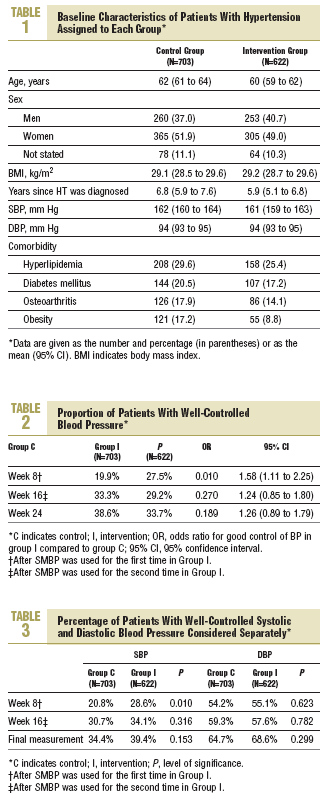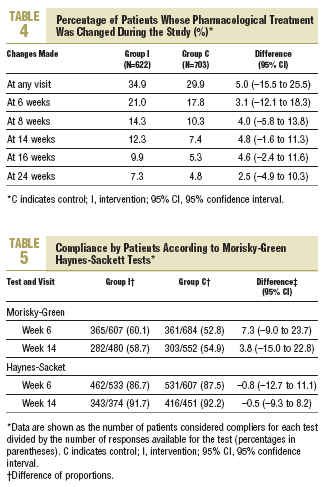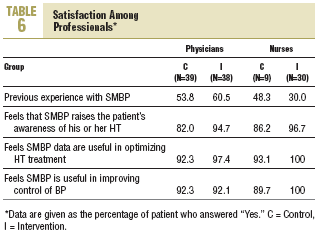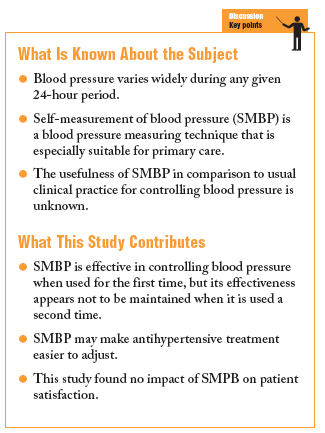6, 8, 14, 16, and 24 weeks). Main outcome measures. Main outcome variable: control of blood pressure, considered systolic/diastolic blood pressure <140/90
mm Hg (130/85 in patients with diabetes). Results. 180 BCUs serving 1325 patients
(622 in the intervention group, 703 in the control group) participated. Baseline characteristics were similar in both groups. Immediately after the first period of SMBP (week 8) the proportion of patients whose blood pressure was well controlled was 7.6% higher in the intervention group than in the control group ( P=.01). After the second period of SMBP (week 16) the difference between groups decreased to 4.1% ( P=.27). At the end of the study the difference was 4.9% ( P=.19). Conclusions. Self-measurement of blood pressure was effective in controlling blood pressure in the short term, but its effects faded over time.
>= 140 o 90 mmHg. Intervenciones. Se facilitaron medidores OMRON-HEM705CP en 2 ocasiones para su utilización durante 15 días (a las semanas 6 y 14). Se registró la presión arterial en cada visita de seguimiento (basal, 6, 8, 14, 16 y 24 semanas). Mediciones principales. Variable principal: control de la presión arterial considerada como PAS/PAD < 140/90 mmHg (130/85 mmHg en pacientes diabéticos). Resultados. Se incluyó a 1.325 pacientes de 185 UBA (622 en el grupo I y 703 en el grupo C), con características basales similares en ambos grupos. Inmediatamente después de la primera AMPA (semana 8), la proporción de pacientes bien controlados fue superior en el grupo I que en el C, con una diferencia del 7,6% (p = 0,01). Tras la segunda utilización (semana 16), esta diferencia se redujo al 4,1% (p = 0,27). Al final del estudio, la diferencia fue del 4,9% (p = 0,19). Conclusiones. La AMPA es efectiva en el control de la presión arterial a corto plazo, pero su efecto se amortigua con el tiempo.
Introduction
The importance of hypertension (HT) as a cardiovascular risk factor has been demonstrated in a number of epidemiological studies.1,2 Nearly all current guidelines and consensus documents recommend accurate stratification of cardiovascular risk, a process which should entail not only screening for cardiovascular risk factors and the presence of target organ lesions or associated chronic disease, but also the accurate measurement of blood pressure (BP) in the doctor's office or in the clinic. Because of the variability of BP, and in order to overcome some of the limitations of blood pressure measurements in the clinic (small number of measurements, lack of information on BP outside the health care setting, white-coat effect, lower precision, and accuracy), current guidelines also recommend that BP be measured outside the clinical setting with (among other approaches) self-measurement of PB (SMBP).3,4
Self-measurement of BP is defined as BP readings obtained outside the clinical setting by persons who are not health professionals--in other words, by patients or persons close to them, usually at home under every-day living conditions. This avoids the white-coat effect,5,6 and repeated BP measurements on the same or different days make it possible to record variability in the patient's BP.7 Certain characteristics of SMBP such as its low cost, ease of use, ability to avoid biases in the readings, and usefulness in the diagnosis of isolated clinical HT, make this BP measurement technique especially advisable for use in primary care.8
The hypothesis this study set out to test was that SMBP would help raise patients' awareness about their condition and the need to comply with treatment,9 and would lead to treatments of HT that are easier to adjust10 in the light of BP figures obtained in the patient's home.11
The Dioampa study was therefore designed to evaluate the effectiveness of SMBP in controlling BP in patients with HT, and its potential impact on treatment adjustment.
Methods
A pragmatic, open, cluster-randomized controlled study12 was designed, and 309 basic health care units (BCU) in primary care centers located throughout Spain were to participate. Each BCU consisted of a physician and a nursing professional with experience working as a team for the follow-up of patients with HT. The BCU that agreed to participate in the study were assigned randomly to the intervention group (I) or the control group (C).
Study Population
Each BCU was responsible for recruiting 8 patients with HT older than 18 years of age whose BP was not well controlled (systolic BP>=140 mm Hg or diastolic BP>=90 mm Hg). All patients gave their informed consent to participate in the study. In all patients we first ruled out secondary HT or other diseases or circumstances that might interfere with follow-up, contraindications for the drugs used to treat HT, pregnancy or breastfeeding. The inclusion of 309 BCU was expected to power the study at 80% to detect 5% differences in a two-tailed test with a 5% level of significance, assuming 16.3% of the patients were well controlled in group C, a within-cluster correlation coefficient of 0.01, and loss of 10 BCU.12
Definition of the Intervention
Patients in group I were asked to undertake SMBP for two 15-day periods (from weeks 6 to 8 and from weeks 14 to 16 after inclusion). They were instructed in how to use the Omron® HME-705CP monitor according to a standardized protocol (3 measurements in the morning before medication, and 3 in the evening before supper).13 The patients were urged to save the print-outs of all BP values and show them to the physician when they returned their monitor. In group C, patients were treated in accordance with usual clinical practice.
Follow-up
In both groups BP was measured at each visit (inclusion, 6, 8, 14, 16, and 24 weeks later) with instruments and procedures used routinely at each BCU. Changes in pharmacological treatment were also recorded at each visit.
The patient's attitude toward antihypertensive treatment was evaluated at 6 and 14 weeks with the questionnaires developed by Morisky-Green and Haynes-Sackett.14 Patient satisfaction was evaluated at the end of follow-up (24 weeks) by summing the scores for the 9 items of a previously validated questionnaire15 for which scores ranged from 7 to 30 (greatest satisfaction). Satisfaction of health professionals was evaluated at the end of the study with a specially designed questionnaire.
Evaluation Criteria and Statistical Analysis
The main outcome measure was control of BP. Control was considered good when systolic BP was <140 mm Hg and diastolic BP was <90 mm Hg in patients without diabetes, and when systolic BP was <130 mm Hg and diastolic BP was <85 mm Hg (measured at the health center) in patients with diabetes. As secondary outcome measures we used control of systolic and diastolic BP separately.
The statistical analysis was based on intention to treat, considering as controls all cases that were not evaluated because of loss to follow-up. Control of BP was analyzed with a generalized linear model assuming binomial errors and a logit link function.16 All levels of significance reported here are for two-tailed tests. Normal approximation was used to calculate 95% confidence intervals (95% CI) for differences between the means and proportions.
The study protocol was approved by the Clinical Research Ethics Committee of the Jordi Gol i Gurina Foundation.
Results
A total of 1325 patients followed at 180 participating BCU were included in the study. There were no significant differences in the baseline characteristics of patients with HT assigned to either group (Table 1).
As Table 2 shows, after the first period of SMPB the proportion of patients whose HT was well controlled was significantly greater in group I. However, no positive effect was seen after the second period of SMBP.
Table 3 shows the percentages of patients whose systolic and diastolic BP were well controlled during the study. In general, the percentage of patients with well controlled HT was higher in group I, although the difference was significant only for systolic BP after the first period of SMBP (week 8).
Table 4 shows the changes in pharmacological treatment during the study. Changes during the 24-week period were somewhat more frequent in group I than in group C, although the differences were not statistically significant. The mean number of changes in treatment during the study was 0.50 in group I and 0.37 in group C, for a difference of 0.13 (95% CI, 0 to 0.26).
The results of tests for compliance with treatment were not available for all patients (Table 5), but showed that the percentage of patients considered compliers was similar in both groups according to the Haynes-Sackett test, and slightly higher in group I according to the Morisky-Green test.
Patient satisfaction, determined for 408 of the 703 (58%) patients in group C and for 367 of the 622 (59%) patients in group I, was greater in the latter group (20.6) than in group C (16.3), by a difference of 4.3 points (95% CI, 4.2 to 12.8).
Satisfaction of health care professionals is shown in table 6. In group I, both physicians and nursing professionals scored higher than in group C with regard to previous experience with SMPB and belief in the usefulness of this approach in optimizing the treatment and control of HT.
The time physicians spent providing instructions to patients on how to use the SMBP monitor was less than 10 min in 62.5% of the cases, and the time nurses spent was 10 to 20 min in 73.3% of the cases.
Discussion
A number of organisms17-19 recommend the use of SMBP. Among other reasons, they suggest that this technique can help improve the control of HT and achieve greater patient involvement in compliance with recommended therapeutic measures.20
Although the number of BCU we analyzed was much lower than the number initially foreseen when we calculated sample size, we found the intervention to have a positive effect after the first period of SMBP between week 6 and week 8. After this brief period the percentage of patients whose BP was reduced to target values was 27.5% in group I. Although the prevalence of obesity was slightly higher in the control group (Table 1), this difference was not statistically significant in light of the effect of the study design (cluster randomization), and in any case was insufficient to account for the finding, given that baseline values for systolic and diastolic BP were practically identical in the 2 groups. The apparent decrease in the effect after the second period with SMBP may be due to extinction of the effect in the medium term (after about 3-4 months) and to dilution owing the greater number of patients lost to follow-up, which were considered failures according to the intention-to-treat analysis.
When we analyzed changes in medication (treatment adjustment) we found them to be more frequent in the intervention group. However, this did not translate as better control of HT in the medium term. It is clear that SMBP is useful in the follow-up of patients with HT since it provides physicians with more BP values, which can then be used as a more solid basis to modify therapy than single BP measurements obtained in the clinic. Moreover, the usefulness of SMBP in selecting patients for participation in clinical trials has been demonstrated.21
Unlike other studies,22,23 our results based on data obtained with the questionnaires of Morisky-Green and Haynes-Sackett failed to show a greater commitment by patients to compliance with therapy.
The lack of clear findings with regard to patient satisfaction may be a result of insufficient sensitivity of the questionnaire we used, which was designed to evaluate satisfaction with general aspects of the care.24 The data provided by health professionals regarding their satisfaction with SMBP were too scarce to draw reliable conclusions. In other studies, improved user satisfaction and adherence to treatment through the use and spread of SMBP have been useful in enhancing the follow-up of patients with HT for longer periods.25
The need for follow-up of patient with HT by both medical and nursing professionals has been well established. The latter are in a better position to carry out health education activities in general and to provide patients with information about SMBP. In the present study nursing staff spent more time teaching and training patients about the self-measurement technique than did physicians. However, in this report we did not analyze the differences between the 2 groups of health care professionals.
A limitation of this study is the smaller number of BCU and patients than in the initial estimate of sample size. This decreased the power of the study to detect differences between the 2 groups, especially in the second evaluation of BP after the second use of SMBP because of the loss of patients to follow-up (20% of the total number of patients).
In conclusion, the results of the present study show that SMBP is effective after an initial period of use, but its effectiveness appeared not to be maintained in a second period of use. This loss of effectiveness may compromise its practical usefulness for achieving good long-term control of blood pressure.
Acknowledgments
We thank Juani Zamora for her help with the statistical analyses, and the principal investigators of the Dioampa group for recruiting patients and gathering data.







